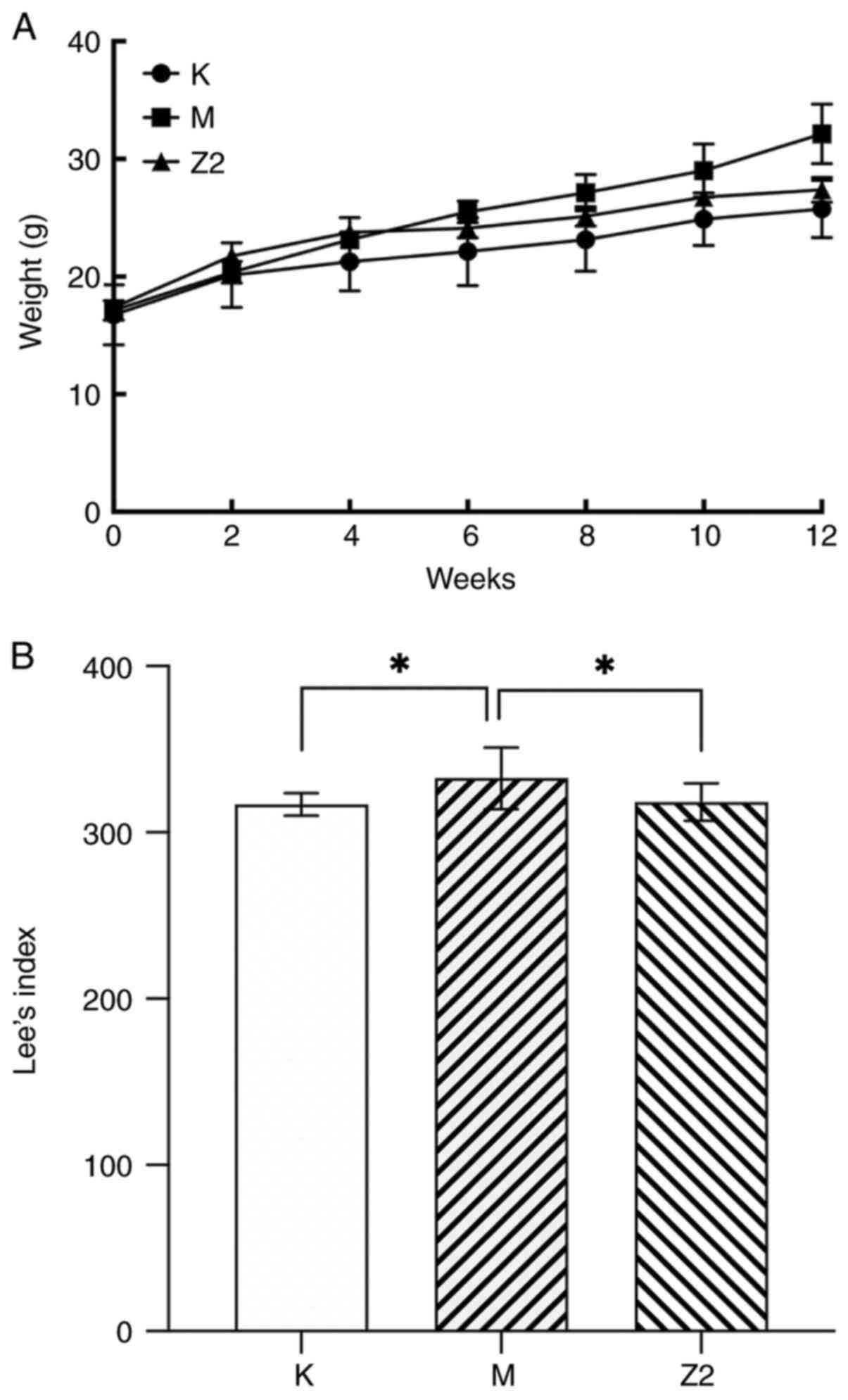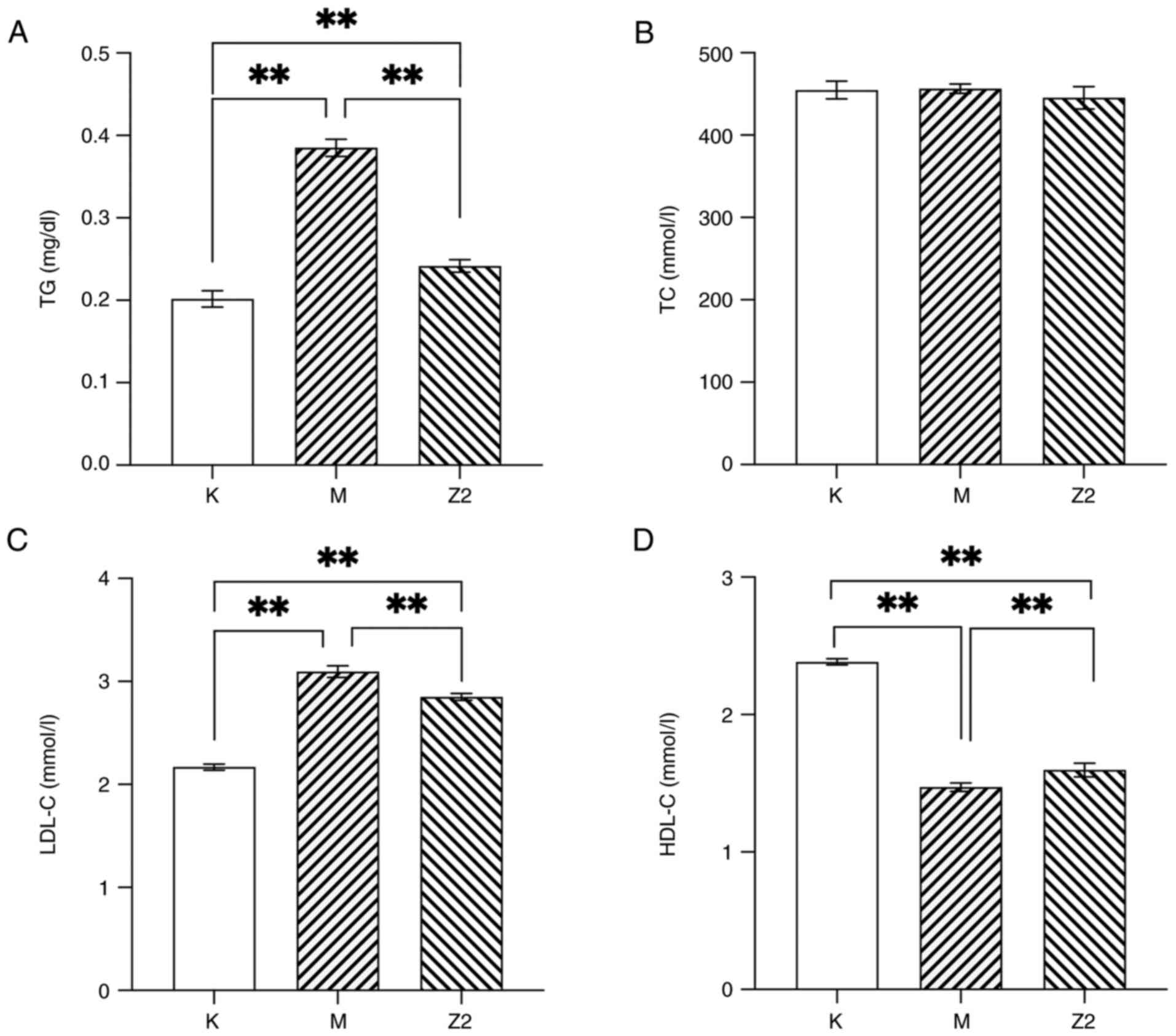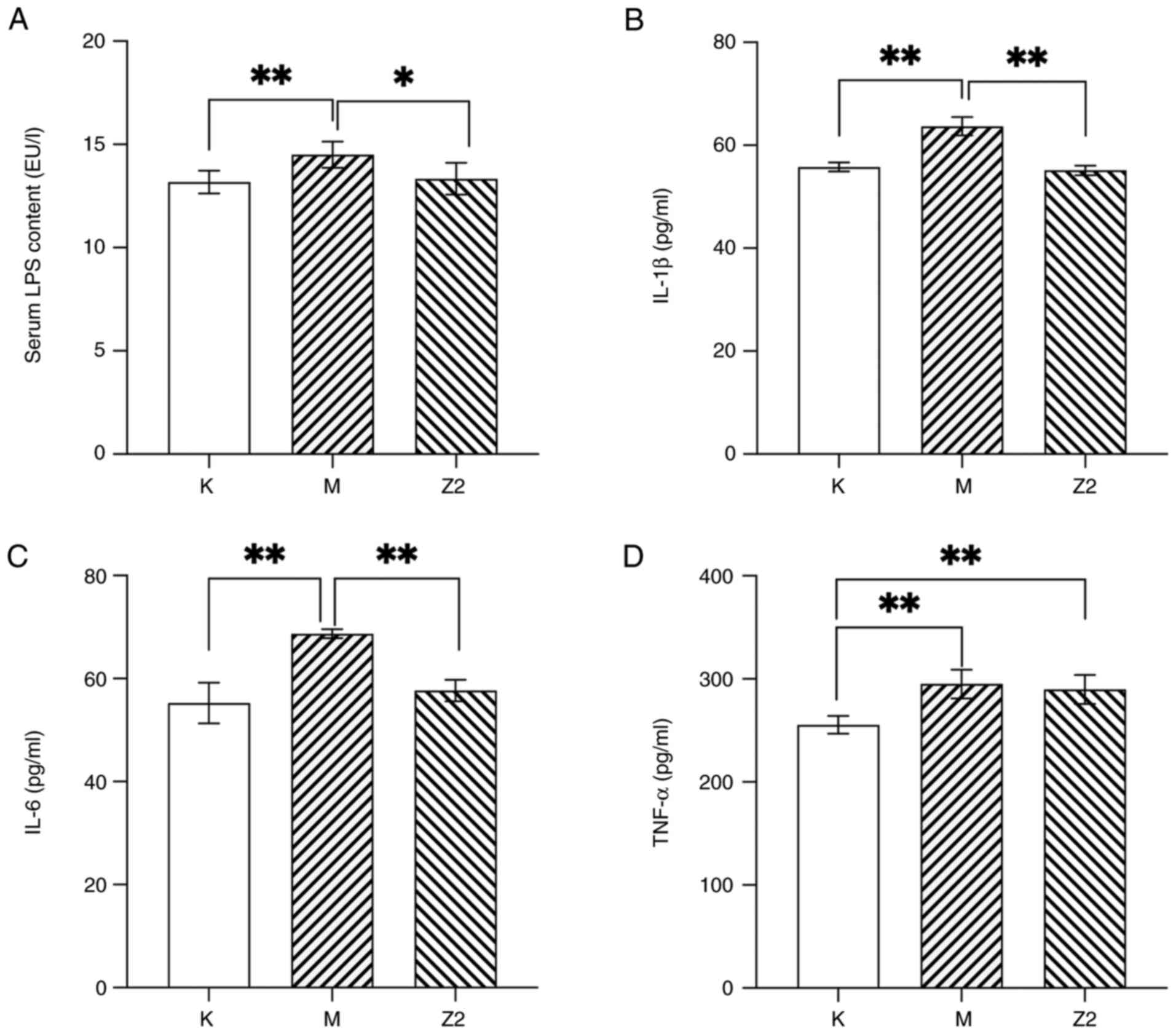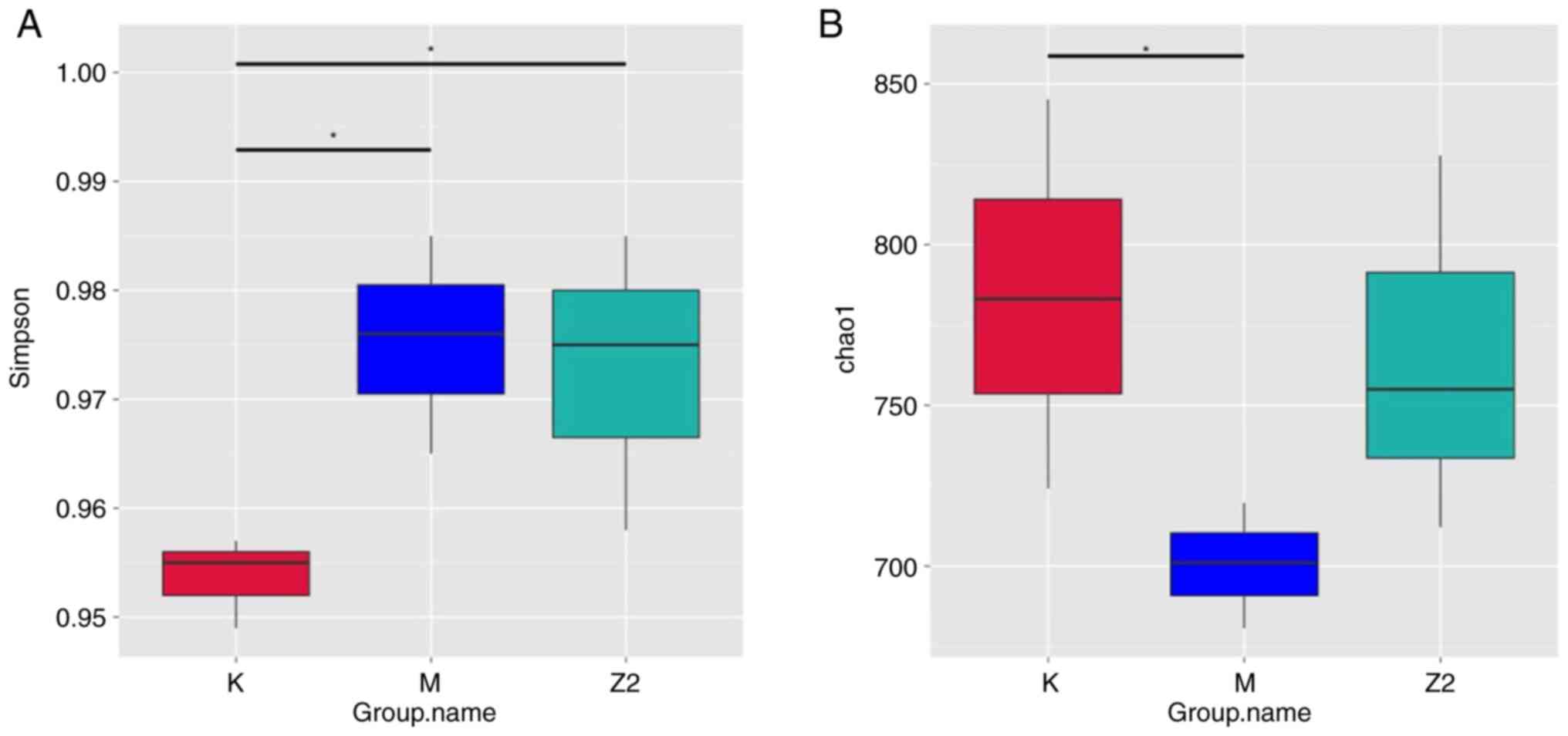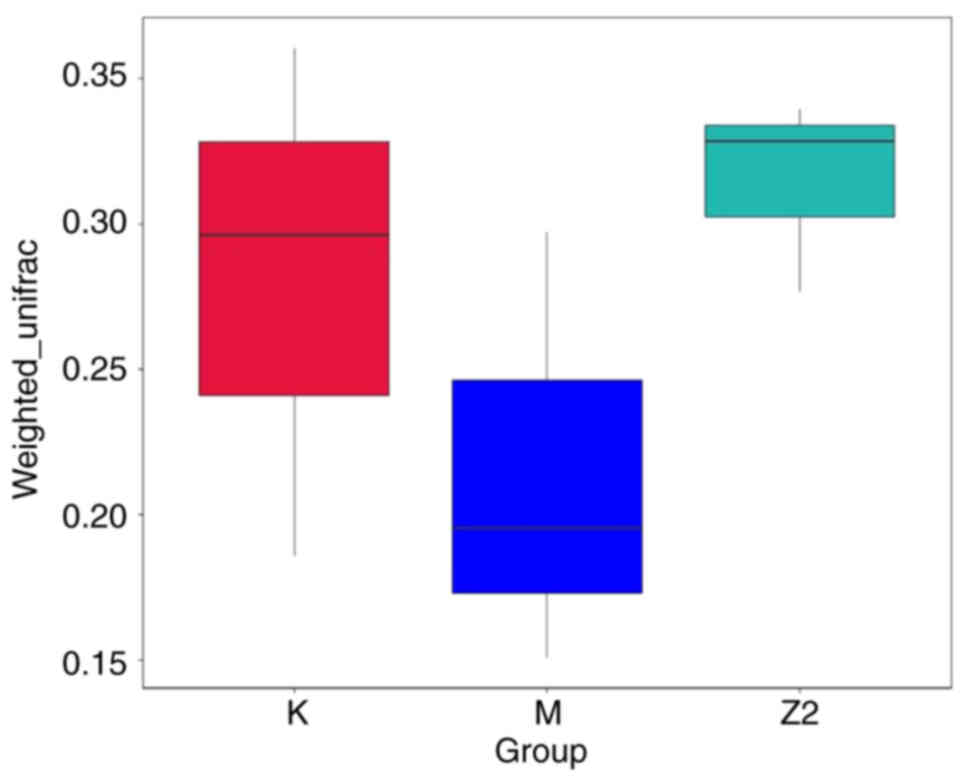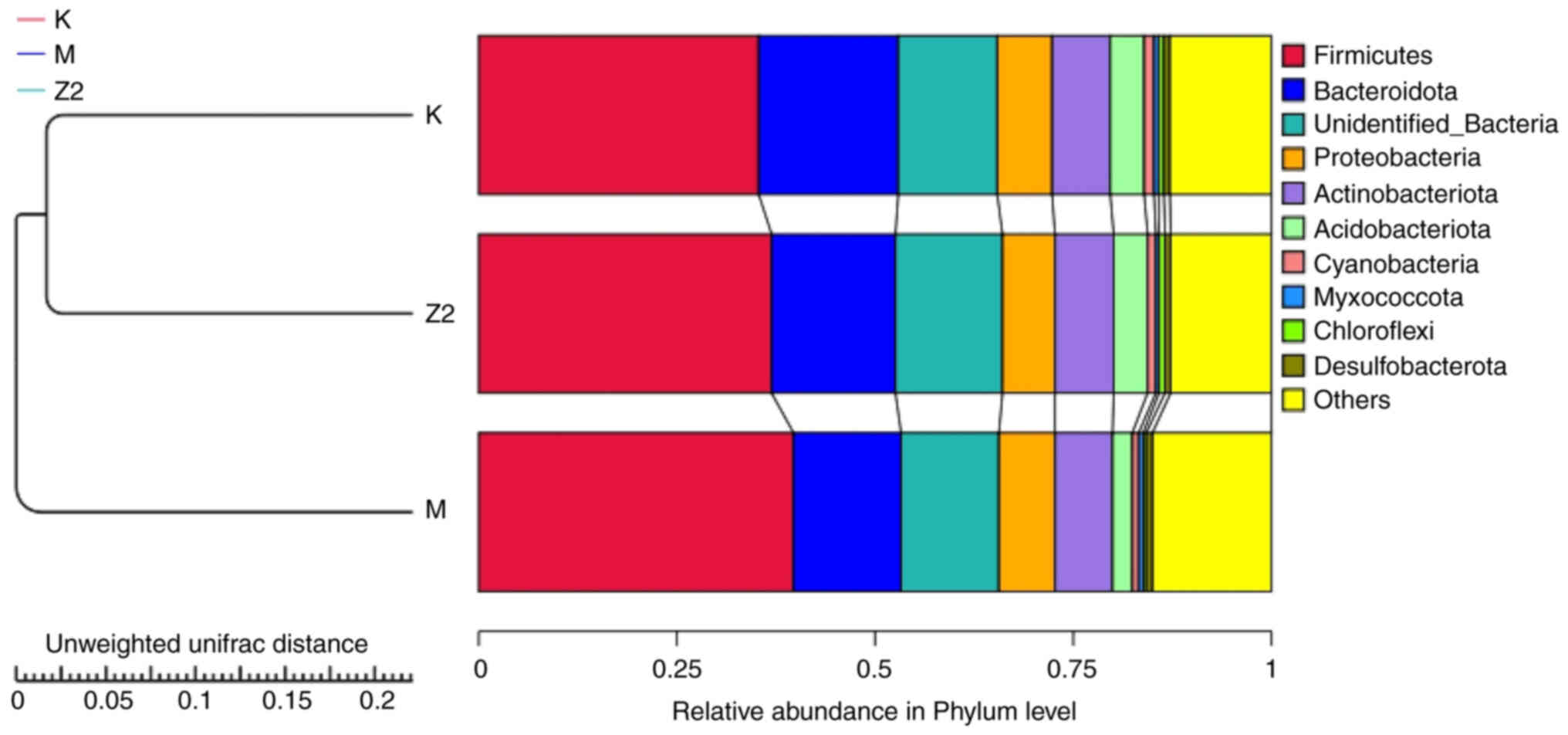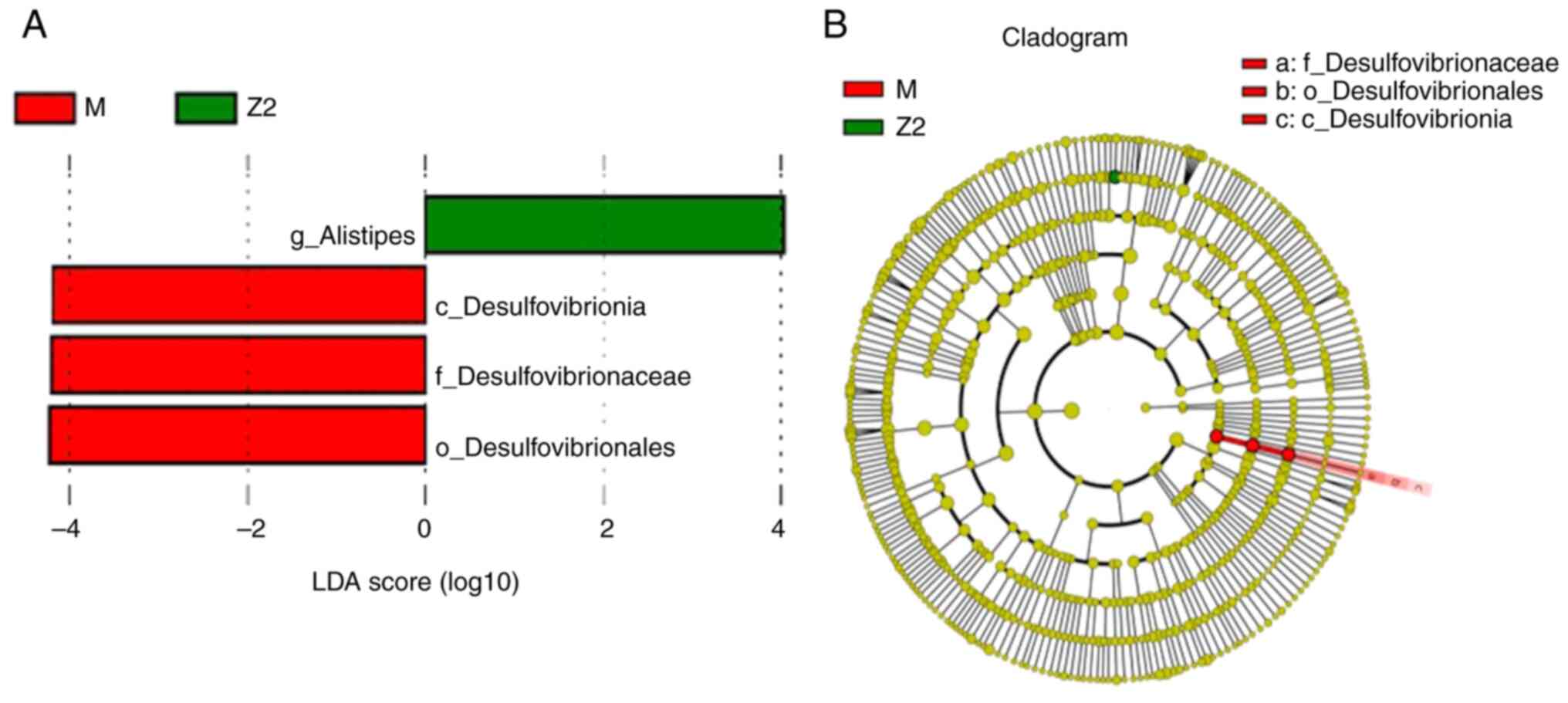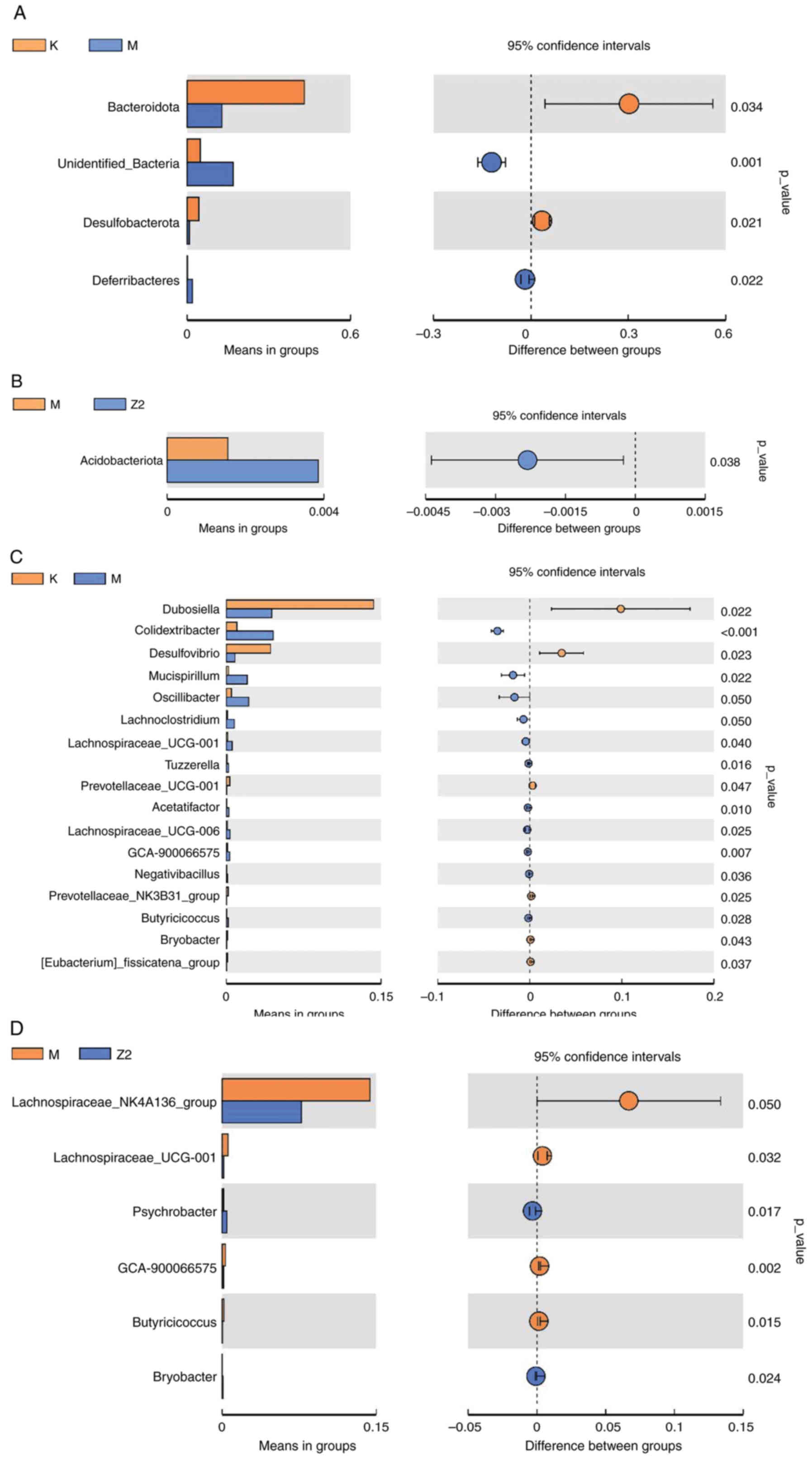Lactoferrin alleviates chronic low‑grade inflammation response in obese mice by regulating intestinal flora
- Authors:
- Published online on: June 13, 2024 https://doi.org/10.3892/mmr.2024.13262
- Article Number: 138
-
Copyright: © Wang et al. This is an open access article distributed under the terms of Creative Commons Attribution License.
Abstract
Introduction
Obesity has become a marked global public health issue that remains challenging to overcome (1,2). The number of individuals who are overweight or obese is notably increasing, particularly in China, due to the rapid progress in socioeconomic development. According to recent studies (3), it has been revealed that >50% of the adult population in China is suffering from obesity or being overweight due to changes in the dietary structure of the Chinese society and the decline in the amount of physical labor hours (4), in addition to genetic, psychosocial and other factors (5).
Obesity is a persistent, asymptomatic inflammatory state characterized by elevated levels of inflammatory markers within the body (6). The uncontrolled growth of the adipose tissue of the body severely affects blood supply; hypoxia resulting from insufficient blood supply can stress and destroy adipocytes, further recruiting macrophages to phagocytose the dead adipocytes (7). The liberation of unbound fatty acids from adipocytes triggers the activation of proinflammatory genes, and the excessive production of inflammatory substances such as interleukin (IL)-6, tumour necrosis factor α (TNF-α) and IL-1β induces a condition of persistent, mild inflammation in the body (8,9). Adipose tissue is an endocrine organ that regulates energy balance in the body, and persistent chronic inflammation interferes with this activity, leading to metabolic disorders in the body (10). Researchers have recently discovered a connection between obesity-induced chronic low-grade inflammation and various cancerous conditions, indicating that the risks of obesity extends beyond this (11,12).
Current research suggests that dysregulation of the microbiota-host balance may be responsible for obesity (13). Hundreds of millions of bacteria reside in the human gut, microorganisms that colonize the human gut shortly after birth and work in coordination with the immune system to counter the effects of changes in the external environment (14). It has been demonstrated that alterations in the intestinal flora and their metabolites trigger multiple inflammatory pathways, and that dysregulation of bile acid metabolism, as well as endotoxemia of intestinal origin, promotes metabolic dysfunction in the body, leading to insulin resistance (15,16). The structure of the gut flora can be influenced by diet, which is considered a notable environmental factor. Diets that are high in saturated fatty acids have the potential to disrupt the structure of the gut flora and affect the barrier protection of the gut (17). In recent years, researchers have been working to find solutions to obesity by targeting the gut flora to improve metabolic disorders (18).
Lactoferrin (LF) is a multifunctional transferrin glycoprotein that is widely distributed in the exocrine fluids of the human body (19). Due to its strong iron chelating ability, LF can compete with harmful intestinal bacteria to grab iron ions thus achieving an antibacterial effect; it has also been shown to have antiviral, anticancer and anti-inflammatory effects and a function in regulating of the immune system (20,21). A previous study demonstrated that LF improves lipid metabolic disorders in obese mice in conjunction with a high-fat diet (22). In the present experiment, the action of LF was delayed and the detection of blood inflammatory factors and the expression of intestinal tight junction proteins was increased.
Materials and methods
Materials and animals
LF was acquired from The Tatua Co-operative Dairy Company Ltd. The purity of LF was 95% with an iron saturation of 15%. The high-fat diet (energy ratio: Protein 18.14%, fat 60.65%, carbohydrate 21.22%) and normal diet (protein 27.5%, fat 11.1%, carbohydrate 67.4%) was obtained from Jiangsu Xietong Pharmaceutical Bio-engineering Co., Ltd.
A total of 30 male 3-week-old C57BL/6 mice (average weight 17±1 g) were obtained from SPF (Beijing) Biotechnology Co., Ltd. All mice were housed at a temperature of 25±1°C and 60±5% humidity with 12 h light/dark cycle, and unrestricted availability to food and water. Food and water were changed daily, while animal health and behavior are monitored once a day. All procedures were carried out following strict ethical guidelines, and every effort was made to minimize animal suffering.
Euthanasia
The experimental animals exhibiting refusal to consume food or water, lack of physical activity, rapid weight loss within a short timeframe or any signs indicating infection will be subjected to euthanasia. However, no such instances were observed in this experiment.
Experimental design
After the C57BL/6J mice were acclimatized and fed a regular diet for 1 week, 10 mice were chosen for the control group (Group K) and continued to be fed a regular diet for 12 weeks. The remaining mice were randomly divided into two groups of 10 mice each; the model group drank purified water and was fed a high-fat diet (Group M), while for the other group, purified water was replaced with 2% LF (23) water after 2 weeks (Group Z2). A brief 2-week high-fat dietary intervention before LF consumption can cause a hepato-intestinal inflammatory state and alterations in bacterial populations in the host (24). The rest of the conditions for Group Z2 were the same as for Group M, and mice were fed until the end of week 12.
During the animal experiments, body weight changes were recorded weekly. At the end of the animal experiment, the experimental animals were subjected to cervical dislocation under anesthesia. Mice were anesthetized with 40 mg/kg pentobarbital sodium solution by intraperitoneal injection. The death of the experimental animal was confirmed by the cessation of breathing, disappearance of reflexes and dilation of pupils. After the animal experiments were completed, the mouse lipid levels, circulating lipopolysaccharide (LPS) levels, serum inflammatory factor levels, intestinal tight junction proteins relative expression were measured.
The analysis of fecal samples was conducted using 16S ribosomal (r)RNA sequencing.
Sample collection
On the day prior to concluding the experiment, the second new fecal pellet of a stressed (pressure exerted on the abdomen) defecation was obtained on a sterilized table and promptly moved to a freezing tube that was sterile and frozen at −80°C. Following collection of fecal samples, the animals underwent a 12-h fasting period, and their body weight and length were measured in order to calculate Lee's index (25). Mice were anesthetized with 40 mg/kg pentobarbital sodium solution by intraperitoneal injection, ~0.8 ml blood was collected under anesthesia through heart puncture and then the mice were euthanized by cervical dislocation, and the collected samples were subsequently preserved at −80°C for future use. The collected blood was centrifuged at 4°C for 10 min at 1,200 × g for serum separation. Animal tissue samples were stored at −80°C.
Serum chemistry analysis
The biochemical indices of total cholesterol (TC; cat. no. ADS-W-ZF014) triglycerides (TG; cat. no. ADS-W-ZF013), low-density lipoprotein (LDL; cat. no. ADS-0428M1) and high-density lipoprotein (HDL; cat. no. ADS-0459M1) in mouse serum were analyzed using commercial enzyme assay kits (Jiangsu Aidisheng Biotechnology). Serum LPS (cat. no. MM-0634M1), interleukin (IL)-6 (cat. no. MM-0163M1), IL-1β (cat. no. MM-0040M1) and tumor necrosis factor-α (TNF-α; cat. no. MM-0132M1) levels were determined using enzyme-linked immunosorbent assay kits (Jiangsu Meimian Industrial Co., Ltd.).
Reverse transcription-quantitative PCR (RT-qPCR)
Briefly, total RNA from mouse intestine tissue was extracted with TransZol (TransGen Biotech Co., Ltd.). The first-strand cDNA was synthesized with a cDNA synthesis kit (Takara Bio, Inc.) through RT kit was used according to the manufacturer's protocol. RT-qPCR was subsequently performed using a SYBR® Green Real-time PCR Master Mix (Toyobo Life Science), qPCR was performed using a 7300 real-time PCR instrument system (Thermo Fisher Scientific, Inc.). PCR was performed in duplicate at 95°C for 3 min and subjected to 40 cycles at 95°C for 5 sec, 60°C for 5 sec and 72°C for 15 sec. To standardize the mRNA levels of all genes, β-actin was employed as an internal control. The relative expression of each gene was determined by the 2−ΔΔCq method (26). The primers used for qPCR are presented in Table SI.
Western blotting
Mouse small intestines tissue were lysed with ice-cold lysis buffer containing RIPA buffer (Beyotime Institute of Biotechnology) and a proteinase inhibitor cocktail (Baiaolaibo Technology, Inc.). The lysates were sonicated with an oscillation frequency of 20–25 kHz at 4°C for 15 sec, followed by centrifugation at 12,000 × g for 15 min at 4°C and the supernatants were retained. Total protein concentration was quantified using a BCA protein assay kit (Epizyme Biomedical Technology, Inc.). Following the total of 30 µg protein/lane were separation of protein samples on a 10% SDS-PAGE gel, an electrophoretic transfer was undertaken to a PVDF membrane. This membrane was subsequently incubated in TBS containing 0.1% Tween-20 and 5% non-fat dry milk powder for a duration of 1 h at ambient temperature, followed by an overnight incubation period at 4°C along with the selected primary antibodies. The primary antibodies included zonula occludens-1 (ZO-1; 1:500; cat. no. bs-1329R; BIOSS), Occludin (1:500; cat. no. bs-10011R; BIOSS) and β-actin (1:10,000; cat. no. AB0035; Shanghai Abways Biotechnology Co., Ltd.). After several washes, the membranes were incubated with an appropriate horseradish peroxidase (HRP)-conjugated secondary antibody (1:1,000; cat. no. A0208; Beyotime Institute of Biotechnology) for 1 h at room temperature. The proteins bands were visualized using enhanced chemiluminescence kits (Sangon Biotech Co., Inc.), and the optical density of the protein bands was quantified using the ImageJ v1.8.0 software (National Institutes of Health), using β-actin as an internal control.
Gut microbiota analysis
Genomic DNA was extracted from mouse feces using hexadecyltrimethylammonium bromide, and its purity and concentration were assessed through agarose gel electrophoresis. A suitable quantity of genetic material was placed into a tube designed for centrifugation, then it was diluted with sterile water until the concentration reached 1 ng/µl. The diluted DNA sample served as a template, and based on the attributes of the sequencing region, specific primers were chosen for barcode primers. To guarantee both efficiency and precision in amplification, Phusion® High-Fidelity PCR primers (New England BioLabs, Inc.) were used to amplify the marker gene for 16S rRNA V4. Primers 515F (5′-GTTTCGGTGCCAGCMGCCGCGGTAA-3′) and 806R (5′-CAGATCGGACTACHVGGGTWTCTAAT-3′) in the 16S V4 region were selected to amplify the DNA samples of each bacterial 16S rRNA gene, 470 bp for length and ‘paired end’ for direction of sequencing. After the completion of amplification, the target bands were thoroughly examined and purified. The assembly of the library was accomplished using the TruSeq® DNA PCR-Free Sample Preparation Kit (New England BioLabs, Inc.). After quantification using Qubit 2.0 (Thermo Fisher Scientific, Inc.) and qPCR, the constructed library underwent qualification before being subjected to sequencing with NovaSeq6000 (Illumina, Inc.).
FLASH (version 1.2.11; http://ccb.jhu.edu/software/FLASH/) was used to splice the measured sequences, and the initial tags underwent quality filtering with specific conditions to eliminate chimeras and obtain the ultimate valid data. Following the identification of chimera, high-quality sequences with up to 97% sequence similarity were clustered into operational taxonomic units (OTUs) and assigned species annotations (27). Every OTU represents the taxonomic levels of phylum, order, family, genus and species. QIIME (version 2) (28) underwent executions of α diversity and β diversity investigations as a means to dissect the intricacy within the samples. Comparing the intricacy of species diversity among samples, α diversity (Chao 1 and Simpson's metric) and β diversity [weighted UniFrac β metrics and unweighted pair-group method with arithmetic mean (UPGMA) clustering] assess the complexity across various samples. The linear discriminant analysis (LDA) effect size (LEfSe) software was used to perform LEfSe (version 1.1.2) analyses, with the LDA score screening value set at 4 (29). Statistical analyses were performed using R statistical software (version 3.0.3) (30). The extraction, detection, and quantitative analysis of gut microbiota in the samples were performed by Wuhan Metware Biotechnology Co., Ltd. (www.metware.cn).
Statistical analysis
The experiments were repeated three times. Statistical analyses were conducted using SPSS (version 26.0; IBM Corp.). The significance of variations among groups was assessed using one-way analysis of variance followed by the LSD test. The Kruskal-Wallis test was used when the data were not able to be properly transformed. Plotting bar graphs were created using GraphPad Prism (version 9.0; Dotmatics). Data are presented as mean ± standard deviation. P≤0.05 was considered to indicate a statistically significant difference.
Results
Impact of LF on body weight and the Lee's index in mice
As the mice aged, their food and water consumption increased. The Z2 group exhibited an increase in their daily water intake. The experiment started with ~8 mm per mouse and ended with ~12 m per mouse. As depicted in Fig. 1A, throughout the entire duration of the animal experiment, mice in the M group exhibited a greater weight gain compared with those in the K group, while the Z2 group, also subjected to a high-fat diet, demonstrated a slower rate of weight gain with LF intervention. Lee's index is a reliable indicator of the correlation between the mass of body fat and the weight of the body. As shown in Fig. 1B, the Lee's index of Group M was significantly higher (P<0.05) compared with that of Group K, indicating that the mouse obesity model was successfully constructed. Compared with group M, Lee's index of Group Z2 exhibited a significant decrease (P<0.05), suggesting that LF has a therapeutic effect on mouse obesity. The Lee's index of mice in Group Z2 was closer to that of mice in Group K and was significantly different from that of mice in Group M (P<0.05).
Effect of LF on blood lipids in mice fed a high-fat diet
A high-fat diet resulted in a significant increase in TG and LDL-C levels (P<0.01) as well as a decrease in HDL-C levels (P<0.01) in Group M compared with Group K, suggesting that abnormalities of lipid metabolism existed in the mice that had been reared on a high-fat diet (Fig. 2). After the intervention, the results showed that LF was able to significantly reduce TG and LDL-C levels in obese mice (P<0.01; Fig. 2A and C), but there was no effect on TC concentration (Fig. 2B). In Fig. 2D, the HDL-C concentration was significantly higher in both Group K and Z2 compared with that in Group M (P<0.01). It can be observed that the intervention of LF can improve dyslipidemia in obese mice.
Effect of LF on intestinal tight junction proteins
In the obese mouse model, the levels of ZO-1 and occludin expression levels were shown to be reduced compared with those in Group K (P<0.05; Fig. 3). After the intervention of LF, it could be observed that the expression of ZO-1 and occludin in Group Z2 gradually recovered, but the difference was not statistically significant.
Effect of LF on serum levels of LPS as well as inflammatory factors
The levels of LPS in the three groups of mice were compared to the potential relationship between chronic low-grade inflammation in obesity and LPS stimulation (Fig. 4A). Compared with Group K, LPS was significantly increased in Group M (P<0.01). However, in Group Z2, there was a decrease in LPS concentration compared with that in Group M (P<0.05). This indicates that LF can reduce elevated LPS levels caused by a high-fat diet.
Blood LPS can activate the relevant inflammatory pathways and promote the release of inflammatory factors (31); therefore, the effect of LF on the serum inflammatory factor mass concentration in experimental mice was further investigated (Fig. 4). Compared with Group K, the mass concentrations of IL-1β, IL-6 and TNF-α were elevated in Group M, and the difference was significant (P<0.01). Compared with Group M, the mass concentrations of IL-1β, IL-6 and TNF-α were reduced in Group Z2, with significant differences in the mass concentrations of IL-1β and IL-6 (P<0.01). These results indicate that consuming a diet rich in fats results in a rise in inflammatory factors within the bloodstream, and that LF reduces the blood mass concentration of inflammatory factors, especially that of IL-1β and IL-6.
Effect of LF on the intestinal flora of mice on a high-fat diet
Analysis of differences between groups in the α diversity indexα diversity is used to indicate the abundance and variety of organisms in a given specimen (32). Chao 1 and Simpson's metrics are shown in Fig. 5; in the Chao 1 index, the difference between group K and group M was significant, and in Simpson's index, group K differed significantly from groups M and Z2. However, the Chao 1 index plot shows that the total number of species in the intestinal flora of mice in Group M was significantly lower compared with that of Group K, and the total number of species in the intestinal flora of mice in Group Z2 was closer to that of the K group. From the Simpson's index plot, it can be observed that the diversity and evenness of species distribution within the bacterial community of Group M were significantly increased, and the diversity and evenness of species distribution within the community of Group Z2 were reduced, which differed significantly from those of Group K. The diversity and evenness of species distribution within the bacterial community of Group Z2 were significantly increased.
β diversity index intergroup difference analysis
Beta diversity is used to compare differences in species composition between communities. Fig. 6 displays the boxplot representation of the analysis of intergroup differences in β diversity. It was revealed that the intestinal flora composition of Group M differed from that of Group K, while the intestinal flora composition of Group Z2 was more similar to that of Group K, but the differences between groups was not significant.
The execution of the UPGMA clustering analysis was facilitated through an unweighted UniFrac distance matrix. The assimilation of the clustering consequences coincided with the proportional prevalence of species at the gateway echelon for every specimen (Fig. 7). Group K and Z2 exhibited a closer clustering, revealing a higher abundance of Firmicutes in Group M compared with Group K and Z2. By contrast, the proportion of Bacteroidota was relatively low. Following the administration of LF, Group Z2 exhibited a comparatively reduced ratio of Firmicutes and an elevated ratio of Bacteroidota, with the Firmicutes/Bacteroidota ratio resembling that of Group K.
Association study of three groups of intestinal flora compartments
Biomarkers that were statistically different between the analyzed groups were investigated using the LEfSe method. The results of the LEfSe histogram and evolutionary branching diagram are shown in Fig. 8, where the abundance of the four species of enterobacteria in the intestinal flora of the two groups was compared, and the difference was statistically significant (P<0.05). Among them, Alistipes was significantly higher in Group Z2 compared with Group M (P<0.05), while Desulfovibrionia, Desulfovibrioniaceae and Desulfovibrionales were more abundant in Group M compared with in Group Z2 (P<0.05).
Analysis of species differences between groups
To look for species that differed between groups at different levels of classification, a t-test test was completed between groups (Fig. 9). At the gate level, the abundance of Deferribacteres was increased, and the abundance of Bacteroidata and Desulfobacterota was decreased in Group M compared with Group K (Fig. 9A); the abundance of Acidobacteriota was significantly higher in Group Z2 compared with Group M (Fig. 9B). At the genus level, the abundance of Colldextribacter, Mucispirillum, Oscillibacter, Lachnoclostridium and Lachnospiraceae-UCG-001 was significantly higher in Group M compared with Group K, while the abundance of Dubosiella and Desulfovibrio was decreased (Fig. 9C); Group Z2 showed relatively higher abundance of Psychrobacter and Bryobacter compared with Group M (Fig. 9D).
Discussion
The present study investigated the impact of LF on lipid metabolism and the composition of intestinal flora in mice that were fed a high-fat diet. Obese mice exposed to a long-term high-fat diet exhibited severe disruption in lipid metabolism and a persistent low-level inflammatory reaction. Following administration of LF, a substantial reduction in Lee's index and serum TC, LDL and levels of inflammatory factors were observed in obese mice; at the same time, serum HDL levels increased. LF-treated mice have improved gut flora structure with weight loss. The results of the current study indicated that LF has a beneficial impact on lipid metabolism and chronic low-grade inflammation in obese mice. Furthermore, the mechanism of action appears to be strongly linked to gut microbiota.
The perception of obesity has shifted, and obesity is not only seen as a change in physical appearance but it is considered a disease. Obesity is accompanied not only by elevated inflammatory markers, but also by a variety of metabolic diseases, including type 2 diabetes, hypertension and dyslipidemia. Central obesity with increased abdominal fat is the main type of obesity leading to metabolic disorders caused by increased inflammatory factors in the body (33). On one hand, macrophage activation in this obese population transforms into a proinflammatory M1 phenotype and infiltrates target organs in large numbers, producing inflammatory factors such as IL-1β, IL-6, TNF-α and others that can affect insulin receptor signaling and generate insulin resistance, which is a key link in the development of metabolic diseases (34–36). On the other hand, elevated concentrations of intestinal-derived LPS in the circulatory system are an independent risk factor for chronic low-grade inflammation, and LPS can stimulate TLR4 to elicit a series of inflammatory cascade responses (37,38). After intervening with LF in mice fed a high-fat diet, a decrease in the levels of LPS, IL-1β and IL-6 was observed in the present study. It can be seen that LF can improve the type of central obesity that is closely associated with increased inflammatory factors, and the role of LF in other metabolic diseases needs to be further explored.
The intestinal tract is exposed to a variety of stimuli from the external environment daily despite the presence of a mucus layer as well as a barrier layer made up of intestinal epithelial cells that help limit the entry of intestinal contents into the body. If the integrity of the intestinal barrier is compromised, intestinal immune homeostasis is also implicated (39). Tight junction proteins are intercellular junction complexes (40) that seal the paracellular space and act as a restriction on the exchange of substances between the gut and the body. The results of the current study showed that the expression of ZO-1 and occludin was significantly reduced in obese mice fed a high-fat diet. This result is detrimental to the integrity of the intestinal barrier and may lead to large amounts of LPS in the intestine entering the circulation with intestinal leakage, triggering an excessive immune response in the intestine and promoting the expression of inflammatory factors (41). The expression of both compact proteins increased in the LF intervention group relative to the high-fat group, although the difference was not significant. It can be argued that LF intervention can increase the expression of intestinal tight junction proteins as a means of limiting intestinal-sourced LPS entry into the bloodstream and attenuating the chronic low-grade inflammatory response at source in obese mice.
The variations in the composition of the gut microbiota among the three mouse groups were also examined in the present study. At the gate level, the findings indicated that the proportion of Firmicutes/Bacteroidota in the gut of mice in the model group was greater compared with Group K and Z2. Although the latter two ratios are more similar, this outcome aligns with the findings of previous studies (42–44). Research on overweight mice has consistently indicated that obesity is frequently accompanied by a higher Firmicutes/Bacteroidota ratio. Additionally, there are chronic low-grade inflammatory response in the intestines and disorders of glucose and lipid metabolism in the body. After a more in-depth analysis of the differences between the intestinal flora compartments of the three groups of mice, the present study revealed that at the phylum-to-genera level, Group M exhibited higher levels of Deferribacteres, Colldextribacter, Mucispirillum, Oscillibacter and Lachnoclostridium compared with Group K. The percentage of these enteric bacteria is elevated in patients with both obesity and intestinal inflammation, and is strongly associated with intestinal infections (45–47). LF intervention in mice fed a high-fat diet was followed by changes in the structure of the intestinal flora, as shown by the LEfSe analysis. Acidobacteriota and Alistipes were elevated in abundance in Group Z2 compared with Group M. Acidobacteriota are bacteria enriched in the gut of healthy individuals (48). Alistipes is a genus in the order Bacteroidetes, an anaerobic bacterium present in the intestinal tract of healthy humans (49). A previous study has shown that the abundance of Alistipes is reduced in the gut of patients with non-alcoholic fatty liver disease with liver fibrosis (50). Alistipes is also a producer of acetic and propionic acids (51), which belong to a group of short-chain fatty acids (SCFAs), a class of metabolites of intestinal flora with anti-inflammatory properties (52). Other findings have shown positive effects of SCFAs on both intestinal barrier integrity and metabolic diseases as well (53–55).
These changes in intestinal flora may be closely related to the role played by LF. In the intestinal ecosystem, LF can achieve bacteriostatic effects through its iron chelating effect to rob iron ions from intestinal pathogenic bacteria and inhibit the formation of pathogenic bacterial biofilm (56), which can help host intestinal microorganisms to increase the resistance of colonization to reduce the threat of potential pathogens (57). Meanwhile, the low-iron environment can promote the growth of probiotics (58), activate intestinal immune cells and maintain the integrity of the intestinal barrier (59). All of these experimental results suggest that LF attenuates the inflammatory response in obese mice, possibly by modulating the structure and relative abundance of the intestinal flora, including a reduction in the abundance of inflammation-associated flora as well as an increase in the abundance of short-chain fatty acid-producing flora.
In conclusion, the present study revealed that LF attenuated the inflammatory response and reduced body weight and lipid levels in HFD-fed mice, and that the underlying mechanisms may be through an increase in intestinal tight junction proteins as well as modulation of the structure and relative abundance of intestinal flora. The current study provides a theoretical basis for LF to be used as a safe, anti-obesity treatment.
Supplementary Material
Supporting Data
Acknowledgements
Not applicable.
Funding
This study was supported by the Inner Mongolia Health Commission Project (grant no. 202202144), the Inner Mongolia Medical University Research Project (grant no. YKD2022MS078) and the Natural Science Foundation of Inner Mongolia Autonomous Region (grant no. 2023LHMS03065).
Availability of data and materials
High-throughput sequencing data have been uploaded to NCBI's SRA database (ID, PRJNA1085847). The other data generated in the present study may be requested from the corresponding author.
Authors' contributions
The animal experiments were conceptualized and overseen by LL. WW was responsible for writing the manuscript as well as data analysis and interpretation. JZ and YL were responsible for acquiring data and writing the manuscript. SS, LW and RH were responsible for analyzing the data. WW and LL confirm the authenticity of all the raw data. All authors read and approved the final manuscript.
Ethics approval and consent to participate
Experimental animal use license no. SYXK-2020-0003. The procedures received approval from the Medical Ethics Committee of Inner Mongolia Medical University (approval no. YKD202301158).
Patient consent for publication
Not applicable.
Competing interests
The authors declare that they have no competing interests.
References
|
Mohammed MS, Sendra S, Lloret J and Bosch I: Systems and WBANs for controlling obesity. J Healthc Eng. 2018:15647482018. View Article : Google Scholar : PubMed/NCBI | |
|
Caballero B: Humans against obesity: Who will win? Adv Nutr. 10:S4–S9. 2019. View Article : Google Scholar : PubMed/NCBI | |
|
Pan XF, Wang L and Pan A: Epidemiology and determinants of obesity in China. Lancet Diabetes Endocrinol. 9:373–392. 2021. View Article : Google Scholar : PubMed/NCBI | |
|
Du SF, Wang HJ, Zhang B, Zhai FY and Popkin BM: China in the period of transition from scarcity and extensive undernutrition to emerging nutrition-related non-communicable diseases, 1949–1992. Obes Rev. 15 (Suppl 1):S8–S15. 2014. View Article : Google Scholar | |
|
Meldrum DR, Morris MA and Gambone JC: Obesity pandemic: Causes, consequences, and solutions-but do we have the will? Fertil Steril. 107:833–839. 2017. View Article : Google Scholar : PubMed/NCBI | |
|
Esser N, Legrand-Poels S, Piette J, Scheen AJ and Paquot N: Inflammation as a link between obesity, metabolic syndrome and type 2 diabetes. Diabetes Res Clin Pract. 105:141–150. 2014. View Article : Google Scholar : PubMed/NCBI | |
|
Longo M, Zatterale F, Naderi J, Parrillo L, Formisano P, Raciti GA, Beguinot F and Miele C: Adipose tissue dysfunction as determinant of obesity-associated metabolic complications. Int J Mol Sci. 20:23582019. View Article : Google Scholar : PubMed/NCBI | |
|
Li H, Meng Y, He S, Tan X, Zhang Y, Zhang X, Wang L and Zheng W: Macrophages, chronic inflammation, and insulin resistance. Cells. 11:30012022. View Article : Google Scholar : PubMed/NCBI | |
|
Leuti A, Fazio D, Fava M, Piccoli A, Oddi S and Maccarrone M: Bioactive lipids, inflammation and chronic diseases. Adv Drug Deliv Rev. 159:133–169. 2020. View Article : Google Scholar : PubMed/NCBI | |
|
Chiurchiu V, Leuti A and Maccarrone M: Bioactive lipids and chronic inflammation: Managing the fire within. Front Immunol. 9:382018. View Article : Google Scholar : PubMed/NCBI | |
|
Iyengar NM, Gucalp A, Dannenberg AJ and Hudis CA: Obesity and cancer mechanisms: Tumor microenvironment and inflammation. J Clin Oncol. 34:4270–4276. 2016. View Article : Google Scholar : PubMed/NCBI | |
|
Kolb R, Sutterwala FS and Zhang W: Obesity and cancer: Inflammation bridges the two. Curr Opin Pharmacol. 29:77–89. 2016. View Article : Google Scholar : PubMed/NCBI | |
|
Clemente JC, Ursell LK, Parfrey LW and Knight R: The impact of the gut microbiota on human health: An integrative view. Cell. 148:1258–1270. 2012. View Article : Google Scholar : PubMed/NCBI | |
|
Chen Y, Cui W, Li X and Yang H: Interaction between commensal bacteria, immune response and the intestinal barrier in inflammatory bowel disease. Front Immunol. 12:7619812021. View Article : Google Scholar : PubMed/NCBI | |
|
Patterson E, Ryan PM, Cryan JF, Dinan TG, Ross RP, Fitzgerald GF and Stanton C: Gut microbiota, obesity and diabetes. Postgrad Med J. 92:286–300. 2016. View Article : Google Scholar : PubMed/NCBI | |
|
Dabke K, Hendrick G and Devkota S: The gut microbiome and metabolic syndrome. J Clin Invest. 129:4050–4057. 2019. View Article : Google Scholar : PubMed/NCBI | |
|
Usuda H, Okamoto T and Wada K: Leaky gut: Effect of dietary fiber and fats on microbiome and intestinal barrier. Int J Mol Sci. 22:76132021. View Article : Google Scholar : PubMed/NCBI | |
|
Xu Z, Jiang W, Huang W, Lin Y, Chan FKL and Ng SC: Gut microbiota in patients with obesity and metabolic disorders-a systematic review. Genes Nutr. 17:22022. View Article : Google Scholar : PubMed/NCBI | |
|
Ramirez-Rico G, Drago-Serrano ME, Leon-Sicairos N and de la Garza M: Lactoferrin: A nutraceutical with activity against colorectal cancer. Front Pharmacol. 13:8558522022. View Article : Google Scholar : PubMed/NCBI | |
|
Antoshin AA, Shpichka AI, Huang G, Chen K, Lu P, Svistunov AA, Lychagin AV, Lipina MM, Sinelnikov MY, Reshetov IV and Timashev PS: Lactoferrin as a regenerative agent: The old-new panacea? Pharmacol Res. 167:1055642021. View Article : Google Scholar : PubMed/NCBI | |
|
Vega-Bautista A, de la Garza M, Carrero JC, Campos-Rodriguez R, Godinez-Victoria M and Drago-Serrano ME: The impact of lactoferrin on the growth of intestinal inhabitant bacteria. Int J Mol Sci. 20:47072019. View Article : Google Scholar : PubMed/NCBI | |
|
Li L, Ma C, Hurilebagen, Yuan H, Hu R and Wang W: Weilisi: Effects of lactoferrin on intestinal flora of metabolic disorder mice. BMC Microbiol. 22:1812022. View Article : Google Scholar : PubMed/NCBI | |
|
Min QQ, Qin LQ, Sun ZZ, Zuo WT, Zhao L and Xu JY: Effects of metformin combined with lactoferrin on lipid accumulation and metabolism in mice fed with high-fat diet. Nutrients. 10:16282018. View Article : Google Scholar : PubMed/NCBI | |
|
Yildirim A, Tamer SA, Sahin D, Bagriacik F, Kahraman MM, Onur ND, Cayirli YB, Kaya ÖT, Aksu B, Akdeniz E, et al: The effects of antibiotics and melatonin on hepato-intestinal inflammation and gut microbial dysbiosis induced by a short-term high-fat diet consumption in rats. Br J Nutr. 122:841–855. 2019. View Article : Google Scholar : PubMed/NCBI | |
|
Yuan E, Duan X, Xiang L, Ren J, Lai X, Li Q, Sun L and Sun S: Aged oolong tea reduces high-fat diet-induced fat accumulation and dyslipidemia by regulating the AMPK/ACC signaling pathway. Nutrients. 10:1872018. View Article : Google Scholar : PubMed/NCBI | |
|
Livak KJ and Schmittgen TD: Analysis of relative gene expression data using real-time quantitative PCR and the 2(−Delta Delta C(T)) method. Methods. 25:402–408. 2001. View Article : Google Scholar : PubMed/NCBI | |
|
Liu H, Chen X, Hu X, Niu H, Tian R, Wang H, Pang H, Jiang L, Qiu B, Chen X, et al: Alterations in the gut microbiome and metabolism with coronary artery disease severity. Microbiome. 7:682019. View Article : Google Scholar : PubMed/NCBI | |
|
Bolyen E, Rideout JR, Dillon MR, Bokulich NA, Abnet CC, Al-Ghalith GA, Alexander H, Alm EJ, Arumugam M, Asnicar F, et al: Reproducible, interactive, scalable and extensible microbiome data science using QIIME 2. Nat Biotechnol. 37:852–857. 2019. View Article : Google Scholar : PubMed/NCBI | |
|
Segata N, Izard J, Waldron L, Gevers D, Miropolsky L, Garrett WS and Huttenhower C: Metagenomic biomarker discovery and explanation. Genome Biol. 12:R602011. View Article : Google Scholar : PubMed/NCBI | |
|
Pannaraj PS, Li F, Cerini C, Bender JM, Yang S, Rollie A, Adisetiyo H, Zabih S, Lincez PJ, Bittinger K, et al: Association between breast milk bacterial communities and establishment and development of the infant gut microbiome. JAMA Pediatr. 171:647–654. 2017. View Article : Google Scholar : PubMed/NCBI | |
|
Ma Q, Li Y, Li P, Wang M, Wang J, Tang Z, Wang T, Luo L, Wang C, Wang T and Zhao B: Research progress in the relationship between type 2 diabetes mellitus and intestinal flora. Biomed Pharmacother. 117:1091382019. View Article : Google Scholar : PubMed/NCBI | |
|
Ding X, Zhou J, Chai Y, Yan Z, Liu X, Dong Y, Mei X, Jiang Y and Lei H: A metagenomic study of the gut microbiome in PTB's disease. Microbes Infect. 24:1048932022. View Article : Google Scholar : PubMed/NCBI | |
|
Iacobini C, Pugliese G, Fantauzzi CB, Federici M and Menini S: Metabolically healthy versus metabolically unhealthy obesity. Metabolism. 92:51–60. 2019. View Article : Google Scholar : PubMed/NCBI | |
|
Saad MJ, Santos A and Prada PO: Linking gut microbiota and inflammation to obesity and insulin resistance. Physiology (Bethesda). 31:283–293. 2016.PubMed/NCBI | |
|
Grandl G and Wolfrum C: Hemostasis, endothelial stress, inflammation, and the metabolic syndrome. Semin Immunopathol. 40:215–224. 2018. View Article : Google Scholar : PubMed/NCBI | |
|
Torres S, Fabersani E, Marquez A and Gauffin-Cano P: Adipose tissue inflammation and metabolic syndrome. The proactive role of probiotics. Eur J Nutr. 58:27–43. 2019. View Article : Google Scholar : PubMed/NCBI | |
|
Orecchioni M, Ghosheh Y, Pramod AB and Ley K: Macrophage polarization: Different gene signatures in M1(LPS+) vs. classically and M2(LPS-) vs. alternatively activated macrophages. Front Immunol. 10:10842019. View Article : Google Scholar : PubMed/NCBI | |
|
Mohammad S and Thiemermann C: Role of metabolic endotoxemia in systemic inflammation and potential interventions. Front Immunol. 11:5941502021. View Article : Google Scholar : PubMed/NCBI | |
|
Peterson LW and Artis D: Intestinal epithelial cells: Regulators of barrier function and immune homeostasis. Nat Rev Immunol. 14:141–153. 2014. View Article : Google Scholar : PubMed/NCBI | |
|
Suzuki T: Regulation of the intestinal barrier by nutrients: The role of tight junctions. Anim Sci J. 91:e133572020. View Article : Google Scholar : PubMed/NCBI | |
|
Di Tommaso N, Gasbarrini A and Ponziani FR: Intestinal barrier in human health and disease. Int J Environ Res Public Health. 18:128362021. View Article : Google Scholar : PubMed/NCBI | |
|
Wang L, Zeng B, Liu Z, Liao Z, Zhong Q, Gu L, Wei H and Fang X: Green tea polyphenols modulate colonic microbiota diversity and lipid metabolism in high-fat diet treated HFA mice. J Food Sci. 83:864–873. 2018. View Article : Google Scholar : PubMed/NCBI | |
|
Ye X, Liu Y, Hu J, Gao Y, Ma Y and Wen D: Chlorogenic acid-induced gut microbiota improves metabolic endotoxemia. Front Endocrinol (Lausanne). 12:7626912021. View Article : Google Scholar : PubMed/NCBI | |
|
Cheng Z, Zhang L, Yang L and Chu H: The critical role of gut microbiota in obesity. Front Endocrinol (Lausanne). 13:10257062022. View Article : Google Scholar : PubMed/NCBI | |
|
Zhou L, Ni Z, Yu J, Cheng W, Cai Z and Yu C: Correlation between fecal metabolomics and gut microbiota in obesity and polycystic ovary syndrome. Front Endocrinol (Lausanne). 11:6282020. View Article : Google Scholar : PubMed/NCBI | |
|
Murros KE, Huynh VA, Takala TM and Saris PEJ: Desulfovibrio bacteria are associated with parkinson's disease. Front Cell Infect Microbiol. 11:6526172021. View Article : Google Scholar : PubMed/NCBI | |
|
Wu M, Li P, An Y, Ren J, Yan D, Cui J, Li D, Li M, Wang M and Zhong G: Phloretin ameliorates dextran sulfate sodium-induced ulcerative colitis in mice by regulating the gut microbiota. Pharmacol Res. 150:1044892019. View Article : Google Scholar : PubMed/NCBI | |
|
Liu S, Li E, Sun Z, Fu D, Duan G, Jiang M, Yu Y, Mei L, Yang P, Tang Y and Zheng P: Altered gut microbiota and short chain fatty acids in Chinese children with autism spectrum disorder. Sci Rep. 9:2872019. View Article : Google Scholar : PubMed/NCBI | |
|
Shkoporov AN, Chaplin AV, Khokhlova EV, Shcherbakova VA, Motuzova OV, Bozhenko VK, Kafarskaia LI and Efimov BA: Alistipes inops sp. nov. and Coprobacter secundus sp. nov., isolated from human faeces. Int J Syst Evol Microbiol. 65:4580–4588. 2015. View Article : Google Scholar : PubMed/NCBI | |
|
Rau M, Rehman A, Dittrich M, Groen AK, Hermanns HM, Seyfried F, Beyersdorf N, Dandekar T, Rosenstiel P and Geier A: Fecal SCFAs and SCFA-producing bacteria in gut microbiome of human NAFLD as a putative link to systemic T-cell activation and advanced disease. United European Gastroenterol J. 6:1496–1507. 2018. View Article : Google Scholar : PubMed/NCBI | |
|
Polansky O, Sekelova Z, Faldynova M, Sebkova A, Sisak F and Rychlik I: Important metabolic pathways and biological processes expressed by chicken cecal microbiota. Appl Environ Microbiol. 82:1569–1576. 2015. View Article : Google Scholar : PubMed/NCBI | |
|
Venegas DP, De la Fuente MK, Landskron G, González MJ, Quera R, Dijkstra G, Harmsen HJM, Faber KN and Hermoso MA: Short chain fatty acids (SCFAs)-mediated gut epithelial and immune regulation and its relevance for inflammatory bowel diseases. Front Immunol. 10:2772019. View Article : Google Scholar : PubMed/NCBI | |
|
Hosseinkhani F, Heinken A, Thiele I, Lindenburg PW, Harms AC and Hankemeier T: The contribution of gut bacterial metabolites in the human immune signaling pathway of non-communicable diseases. Gut Microbes. 13:1–22. 2021. View Article : Google Scholar : PubMed/NCBI | |
|
Liu W, Luo X, Tang J, Mo Q, Zhong H, Zhang H and Feng F: A bridge for short-chain fatty acids to affect inflammatory bowel disease, type 1 diabetes, and non-alcoholic fatty liver disease positively: By changing gut barrier. Eur J Nutr. 60:2317–2330. 2021. View Article : Google Scholar : PubMed/NCBI | |
|
Peng K, Xia S, Xiao S and Yu Q: Short-chain fatty acids affect the development of inflammatory bowel disease through intestinal barrier, immunology, and microbiota: A promising therapy? J Gastroenterol Hepatol. 37:1710–1718. 2022. View Article : Google Scholar : PubMed/NCBI | |
|
Kell DB, Heyden EL and Pretorius E: The biology of Lactoferrin, an iron-binding protein that can help defend against viruses and bacteria. Front Immunol. 11:12212020. View Article : Google Scholar : PubMed/NCBI | |
|
Sanders ME, Merenstein DJ, Reid G, Gibson GR and Rastall RA: Probiotics and prebiotics in intestinal health and disease: From biology to the clinic. Nat Rev Gastroenterol Hepatol. 16:605–616. 2019. View Article : Google Scholar : PubMed/NCBI | |
|
Carr LE, Virmani MD, Rosa F, Munblit D, Matazel KS, Elolimy AA and Yeruva L: Role of human milk bioactives on Infants' gut and immune health. Front Immunol. 12:6040802021. View Article : Google Scholar : PubMed/NCBI | |
|
Galdeano CM, Cazorla SI, Dumit JM, Velez E and Perdigon G: Beneficial effects of probiotic consumption on the immune system. Ann Nutr Metab. 74:115–124. 2019. View Article : Google Scholar : PubMed/NCBI |



